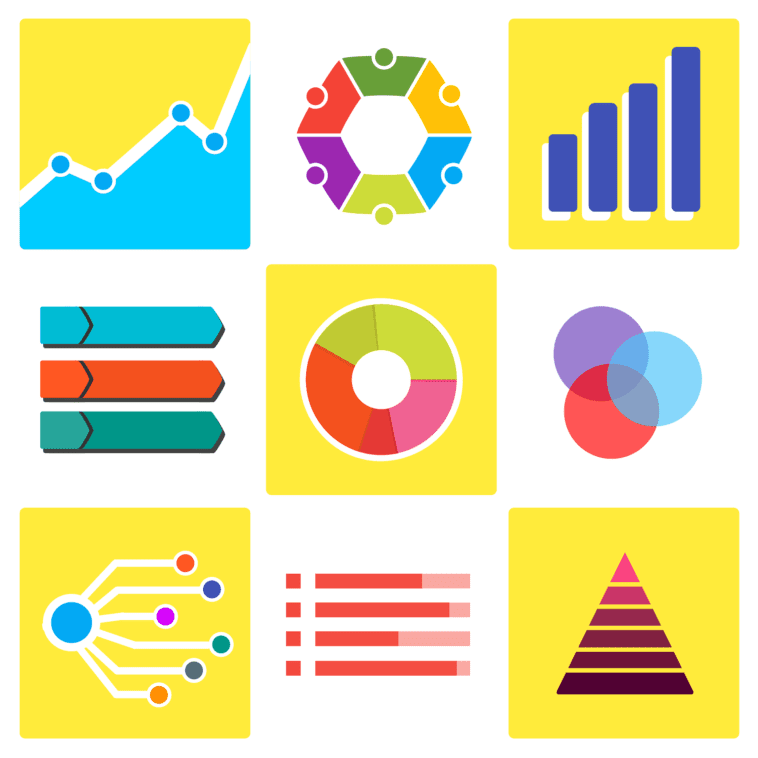An infographic is n graphic with minimal text designed to provide easy-to-understand information about a specific topic. Infographics need to be engaging and simple, providing specific information that viewers want. With careful planning, you can create an infographic on a business or marketing topic that’s well-received.
Clarify the Purpose
Determine the specific purpose of the infographic before creating it. The purpose might be to educate readers on a subject or present new research about a topic.
- The purpose of an infographic often determines its overall success.
- Know what you want your readers to do after they view your infographic.
Define the Audience
Determine the target audience of the infographic before creating it. Know the social status, gender, and interests of the target audience.
- Defining the audience enables you to home in on the best tone and style for the infographic.
- The audience determines the best colors and writing style.
Gather Information
Compile information to include in the infographic carefully. Be ready to consult with an expert if necessary.
- Determine the essential information for the infographic, and focus on these details.
- Add citations if you use outside sources.
Sketch Potential Designs
Take time to sketch potential designs to find the best one. Build your design around the information you want to include.
- Infographics might have a timeline format.
- Infographics can also feature numbered or bulleted lists.
- If you have multiple sections, define them clearly.
Create a Wireframe
After determining the best format and layout, work on the wireframe. A wireframe is a black-and-white mock-up of the infographic with the dimensions you will use.
- Distribute the text over the infographic design next, deciding on the sizing and distance between all elements.
- Leave negative space between text sections and elements to enhance readability.
Select Colors
Your color scheme is as crucial as the information itself. Colors have a direct correlation with how viewers will perceive the information.
- Colors can evoke different emotions in viewers.
- Consider using a brand’s colors in an infographic if it’s connected with a business.
Consider Graphs and Charts
Present numbers and statistics with graphs and charts. These elements make it easy for viewers to take in the information.
- Use bar charts or line graphs for comparing numbers over time.
- Use pie charts to show proportions.
- Use bubble charts to visualize three types of data at once.
Select Fonts
Fonts have a direct impact on readability. Don’t choose overly fancy fonts; they can be distracting.
- If you want to use a weird or fancy font, use it for the title only.
- Combine up to three different fonts in the infographic, as long as they complement each other.
- Choose font colors that contrast with the background colors.
- Choose a font size that makes it easy to scan the infographic.
Use Images to Illustrate Ideas
Images in an infographic enable you to use fewer words. Consider images to be a powerful communication tool.
- Icons are simple drawings that accent bullet points and paragraphs.
- Illustrations help infographics feel unique and appealing.
- Photos can be an effective addition, either for backgrounds or as design elements.
Test and Revise
After finishing an infographic, test it with a few different color schemes and layouts. Keep the key information the same while testing the look of your graphic.
- Try looking at the mock-ups from a slight distance with your eyes partially closed to determine which elements you notice first.
Additional Resources
- Ultimate Infographic Design Guide: A template may be helpful for planning the layout of an infographic.
- How to Make a Successful Infographic: An effective infographic has an attention-getting header and a simple layout.
- Infographics and Flyers: Users may be more likely to respond to the graphical content of an infographic than they would text-heavy content.
- The Art of Infographics: Data visualization typically includes charts, and infographics are designed to tell a story. Data visualization doesn’t include an infographic, but infographics can include data visualization.
- Introduction to Data Visualization and Infographics: The word “infographic” combines the words “information” and “graphic.”
- Infographic Planning Worksheet: Use this worksheet to plan an infographic, from brainstorming your topic to sketching the layout.
- Infographic Design Basics: An infographic needs a specific focus to impart to your audience.
- What Are Infographics? Seven Common Types of Infographics: This video tutorial presents seven different types of infographic designs that you can use to present information.
- Using Infographics in the Classroom: Because infographics present succinct information, they are ideal for use in the classroom.
- Ten Do’s and Don’ts for Creating Infographics: Cite sources you use for your infographic, including links to sources when possible.
- Infographics and Visualization: Infographics need to not only be visually appealing but also be functional and easy to understand.
- Infographic Information: An effective infographic is a balance of information and graphics without too much text.
- The Whats, Whys, and Hows of Infographic Assignments: Infographics can be informative, instructive, descriptive, or persuasive in nature.
- What Are Infographics? Infographics are an effective way to maintain people’s interest as you provide information.
- A Brief Rhetoric of Infographic Design: Although infographics need to have a simple design, the process of designing them can be very complex.
- Designing Infographics: Static infographics are designed for printing, while animated infographics are designed to be viewed online or with animation software.
- Infographic Aesthetics: Designing for the First Impression: Many companies have begun using infographics as an effective means of capturing readers’ attention.
- Infographics: Data Visualization: Infographics help enhance readers’ perception of data trends and help them retain the information more effectively.
- How to Create an Infographic: Consider what you want to communicate and determine your audience before you create an infographic.
- How to Pick Colors: Color-pickers enable you to establish a color palette for your infographic.
- The Graphic Designer’s Guide to the Psychology of Color: Color psychology studies how colors affect both behaviors and emotions.
- The Psychology of Color and Graphic Design: Warm colors such as red and orange often evoke positive and happy responses.
- What Exactly Is the Psychology of Color? Color psychology suggests that blue evokes calmness and peace.
- Color Psychology and Graphic Design: Business Applications: Color has an influence on perception and preferences, so choose colors carefully when creating an infographic.
- Color and its Influence on Visual Communication: Colors stimulate the senses, symbolize concepts, and trigger memories and emotional responses.
- The Aesthetics of Reading: Typography and font choices have an impact on how readers perceive the message.
- Five Tips for Designing an Infographic: White space on an infographic helps make it more visually appealing and simple.
- Effective Infographics for Marketing: Outline the story you want to tell before you design your infographic.
- Text Uses and Strategies: Position text near the element it refers to for readers’ ease, also making the text the same color as the visual element as long as the text is easy to read.

